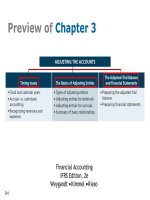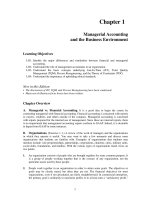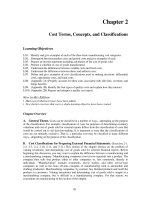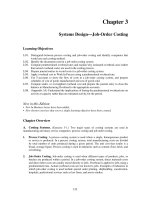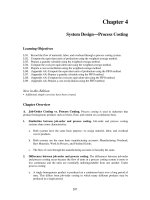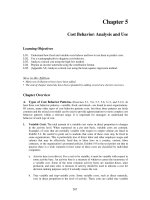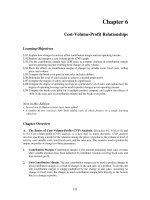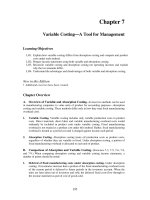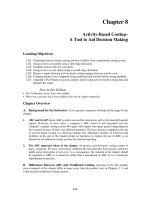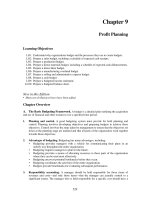Overview managerial accounting chapter 03
Bạn đang xem bản rút gọn của tài liệu. Xem và tải ngay bản đầy đủ của tài liệu tại đây (3.13 MB, 75 trang )
Chapter 3
Systems Design—Job-Order Costing
Learning Objectives
LO1. Distinguish between process costing and job-order costing and identify companies that
would use each costing method.
LO2. Identify the documents used in a job-order costing system.
LO3. Compute predetermined overhead rates and explain why estimated overhead costs (rather
than actual overhead costs) are used in the costing process.
LO4. Prepare journal entries to record costs in a job-order costing system.
LO5. Apply overhead cost to Work In Process using a predetermined overhead rate.
LO6. Use T-accounts to show the flow of costs in a job-order costing system, and prepare
schedules of cost of goods manufactured and cost of goods sold.
LO7. Compute under- or overapplied overhead cost and prepare the journal entry to close the
balance in Manufacturing Overhead to the appropriate accounts.
LO8. (Appendix 3A) Understand the implications of basing the predetermined overhead rate on
activity at capacity rather than on estimated activity for the period.
New in this Edition
• New In Business boxes have been added.
• New shorter exercises that cover a single learning objective have been created.
Chapter Overview
A. Costing Systems. (Exercise 3-1.) Two major types of costing systems are used in
manufacturing and many service companies: process costing and job-order costing.
1.
Process Costing. A process costing system is used where a single, homogeneous product
or service is produced. In a process costing system, total manufacturing costs are divided
by total number of units produced during a given period. The unit cost that results is a
broad, average figure. Process costing is used in industries such as cement, flour, brick, and
oil refining.
2.
Job-Order Costing. Job-order costing is used when different types of products, jobs, or
batches are produced within a period. In a job-order costing system, direct materials costs
and direct labor costs are usually traced directly to jobs. Overhead is applied to jobs using a
predetermined rate. Actual overhead costs are not traced to jobs. Examples of industries in
which job-order costing is used include special order printing, shipbuilding, construction,
hospitals, professional services such as law firms, and movie studios.
133
Note that in some situations either job-order costing or process costing could be used,
depending on the level of detail needed and the desires of management.
B. Job-Order Costing—An Overview. (Exercises 3-2, 3-3, 3-9, 3-11, 3-12, 3-13, 3-15,
and 3-16.) The discussion in the text and below assumes that a paper-based manual system is
used for recording costs. Cost and other data are recorded on materials requisition forms, time
tickets, and job cost sheets. Of course, many companies now enter cost and other data directly
into computer databases and have dispensed with these paper documents. Nevertheless, the data
residing in the computer typically consists of a “virtual” version of the manual system. Since a
manual system is easy for students to understand, we continue to rely on it when describing a
job-order costing system.
1.
Job Cost Sheet. Each job has its own job cost sheet on which costs are charged to the job.
The job cost sheet will have some code or descriptive data to identify the particular job and
will contain spaces to record costs of materials, labor, and overhead. Exhibit 3-4 provides
an illustration of a job cost sheet.
2.
Materials Costs. When a job is started, materials that will be required to complete the job
are withdrawn from the storeroom. The document that authorizes these withdrawals and
that specifies the types and amounts of materials withdrawn is called the materials
requisition form. The materials requisition form identifies the job to which the materials
are to be charged. Care must be taken when charging materials to distinguish between
direct and indirect materials. An example of a materials requisition form is shown in
Exhibit 3-1 in the text.
3.
Labor. Labor costs are recorded on a document called a time ticket or a time sheet. Each
employee records the amount of time he or she spends on each job and each task on a time
ticket. The time spent on a particular job is considered direct labor and its cost is traced to
that job. The cost of time spent on other tasks, not traceable to any particular job, is usually
considered part of manufacturing overhead. An example of an employee time ticket is
shown in Exhibit 3-3 in the text.
4.
Manufacturing Overhead. Manufacturing overhead includes all manufacturing costs that
are not traced to a particular job. In practice, manufacturing overhead usually consists of all
manufacturing costs other than direct materials and direct labor. Since manufacturing
overhead costs are not traced to jobs, they must be allocated to jobs if absorption costing is
used.
a. We do not dwell on the reasons for allocating all manufacturing overhead to jobs in this
chapter. What costs should or should not be allocated to jobs and to products remains a
controversial issue. In the chapter we confine discussion to absorption costing since
that is the approach that is used in the vast majority of organizations for both external
and internal reporting.
b. In order to allocate overhead costs, management must choose an allocation base. The
most widely used allocation bases are direct labor-hours, direct labor costs, and
machine-hours. (These bases have been severely criticized in recent years. Critics
charge that overhead is largely unrelated to, or even negatively correlated with,
machine-hours or direct labor-hours.) In the costing system illustrated in the chapter, a
predetermined overhead rate is computed by dividing the estimated total overhead for
the upcoming period by the estimated total amount of the allocation base.
134
c. Ideally overhead cost should be strictly proportional to the allocation base; in other
words, an x% change in the allocation base should cause an x% change in the overhead
cost. Only then will the allocated overhead costs be useful in decision-making and in
performance evaluation. However, much of the overhead typically consists of costs that
are not proportional to any conceivable allocation base and hence any scheme for
allocating such costs will inevitably lead to costs that are biased and unreliable for
decision-making and performance evaluation. In practice, the overriding concern is to
select some basis or bases for allocating all overhead costs and scant attention is paid to
questions of causality. These issues are not raised in the text at this point since students
will not be ready to understand them until after having studied cost behavior in more
depth in later chapters.
d. At any rate, the actual amount of the allocation base incurred by a job is recorded on
the job cost sheet. The actual amount of the allocation base is then multiplied by the
predetermined overhead rate to determine the amount of overhead that is applied to the
job.
C. Job Order Costing—The Flow of Costs. (Exercises 3-4, 3-10, 3-13, 3-14, 3-15, and
3-17.) Exhibit 3-14 in the text provides a model for the cost flows in a job-order costing system.
1.
Overview of Cost Flows. The basic flow of costs in a job-order system begins by
recording the costs of material, labor, and manufacturing overhead.
a. Direct material and direct labor costs are debited to the Work In Process account. Any
indirect material or indirect labor costs are debited to the Manufacturing Overhead
control account, along with any other actual manufacturing overhead costs incurred
during the period. Manufacturing overhead is applied to Work In Process using the
predetermined rate. The offsetting credit entry is to the Manufacturing Overhead
control account.
b. The cost of finished units is credited to Work In Process and debited to the Finished
Goods inventory account.
c. When units are sold, their costs are credited to Finished Goods and debited to Cost of
Good Sold.
2.
The Manufacturing Overhead Control Account. Manufacturing Overhead is a
temporary control account.
a. As stated above, actual overhead costs are recorded on the debit side of the
Manufacturing Overhead control account. Overhead costs applied to Work in Process
using predetermined rates are recorded on the credit side of the account.
b. Any discrepancy between overhead costs incurred and overhead costs applied shows up
as a balance in the Manufacturing Overhead control account at the end of the period. A
debit balance is called underapplied overhead and a credit balance is called overapplied
overhead.
D. Under- and Overapplied Overhead. (Exercises 3-6, 3-7, 3-8, 3-13, 3-14, 3-16 and 317.) Since the predetermined overhead rate is based entirely on estimated data, the actual amount
135
of overhead cost incurred will almost always differ from the amount of overhead cost that is
applied to the Work In Process account. The difference is termed underapplied or overapplied
overhead, and as discussed above, can be determined by the ending balance in the
Manufacturing Overhead control account. An underapplied balance occurs when more overhead
cost is actually incurred than is applied to the Work In Process account. An overapplied balance
results from applying more overhead to Work In Process than is actually incurred.
1.
Cause of Under- and Overapplied Overhead. When a predetermined overhead rate is
used, it is implicitly assumed that the overhead cost is variable with (i.e., proportional to)
the allocation base. For example, if the predetermined overhead rate is $20 per direct laborhour, it is implicitly assumed that the actual overhead costs will increase by $20 for each
additional direct labor-hour that is incurred. If, however, some of the overhead is fixed with
respect to the allocation base, this will not happen and there will be a discrepancy between
the actual total amount of the overhead and the overhead that is applied using the $20 rate.
In addition, the actual total overhead can differ from the estimated total overhead because
of poor controls over overhead spending or because of inability to accurately forecast
overhead costs.
2.
Disposition of Under- and Overapplied Overhead. Two approaches to dealing with an
under- or overapplied overhead balance in the accounts are illustrated in the text.
a. The simplest approach is to close out the under- or overapplied overhead to Cost of
Goods Sold. This is the method that is used in most of the exercises and problems
because it is easiest for students to understand and master.
b. The second approach is to allocate the under- or overapplied balance to Cost of Goods
Sold and to the Work In Process and Finished Goods inventory accounts. The basis of
allocation is the amount of overhead applied during the period in the ending balance of
each of these accounts. This method is equivalent to waiting until the end of the period
to allocate the actual overhead costs based on the actual amount of the allocation base
incurred.
3.
The Effect of Under- and Overapplied Overhead on Net Operating Income.
a. If overhead is underapplied, less overhead has been applied to inventory than has
actually been incurred. Enough overhead must be added to Cost of Goods Sold (and
perhaps ending inventories) to eliminate this discrepancy. Since Cost of Goods Sold is
increased, underapplied overhead reduces net income.
b. If overhead is overapplied, more overhead has been applied to inventory than has
actually been incurred. Enough overhead must be removed from Cost of Goods Sold
(and perhaps ending inventories) to eliminate this discrepancy. Since Cost of Goods
Sold is decreased, overapplied overhead increases net operating income.
E. The Predetermined Overhead Rate and the Level of Activity (Appendix 3A).
(Exercise 3-16.) Interest has been recently rekindled in the issue of how to select the
denominator level of activity in the predetermined overhead rate. In the main body of the
chapter, it is assumed that the denominator is the estimated total amount of the allocation base
for the period. While this is the most common method used in practice, it has some serious
drawbacks.
136
1. Drawbacks of basing the predetermined overhead rate on the estimated level of
activity.
a. If overhead contains substantial fixed costs, then as the estimated level of activity
decreases, the predetermined overhead rate will increase. Thus if the company starts
losing sales due to a recession or other reason, the company’s unit costs will increase.
This could result in some managers increasing prices or dropping products, which is
likely to be exactly the wrong thing to do in this situation.
b. Products are charged with resources they don’t use. If a product uses 10% of the
capacity of a fixed resource, it is argued that it should be charged with only 10% of the
cost of that resource. If all of the products a company makes use only 50% of the
capacity of the fixed resource, the cost of that idle capacity should be separately
recognized as a period expense rather than spread over the products that use the
resource during the period. Under the conventional approach, products are charged for
both their share of the capacity they use and for a share of the idle capacity they do not
use. So if a product uses 10% of the capacity of a resource, but 50% of the capacity is
idle, then under the conventional approach the product would be charged with 20% of
the total cost of the resource.
2.
Suggested solution. It has been suggested that predetermined overhead rates should be
based on the amount of the allocation base at capacity rather than on the estimated amount
of the allocation base for the upcoming period. This proposal would result in stable unit
costs that do not rise and fall with decreases and increases in the expected level of activity.
The underapplied overhead that results from the discrepancy between the actual level of
activity and the level of activity at capacity can be treated as a period expense and taken
directly to the income statement. In the text we suggest the title “Cost of Unused Capacity”
for this income statement item, but other names would work as well. By showing this
amount separately, the cost of idle capacity is highlighted for management attention. For a
good discussion of these issues, we recommend the IMA’s Statement on Management
Accounting 4Y, Measuring the Cost of Capacity, March 31, 1996. Even though we have a
great deal of sympathy with this proposal, we continue to use the conventional approach in
the main body of the text since it still predominates in practice.
137
Assignment Materials
Assignment
Exercise 3-1
Exercise 3-2
Exercise 3-3
Exercise 3-4
Exercise 3-5
Exercise 3-6
Exercise 3-7
Exercise 3-8
Exercise 3-9
Exercise 3-10
Exercise 3-11
Exercise 3-12
Exercise 3-13
Exercise 3-14
Exercise 3-15
Exercise 3-16
Exercise 3-17
Problem 3-18
Problem 3-19
Problem 3-20
Problem 3-21
Problem 3-22
Problem 3-23
Problem 3-24
Problem 3-25
Problem 3-26
Problem 3-27
Problem 3-28
Problem 3-29
Problem 3-30
Problem 3-31
Problem 3-32
Case 3-33
Case 3-34
Case 3-35
Level of
Topic
Difficulty
Process costing and job-order costing ...................................
Basic
Job-order costing documents.................................................
Basic
Compute the predetermined overhead rate............................
Basic
Prepare journal entries...........................................................
Basic
Apply overhead .....................................................................
Basic
Applying overhead; cost of goods manufactured ..................
Basic
Prepare T-accounts ................................................................
Basic
Under- and overapplied overhead .........................................
Basic
Departmental overhead rates .................................................
Basic
Journal entries and T-accounts ..............................................
Basic
Applying overhead in a service company..............................
Basic
Varying predetermined overhead rates..................................
Basic
Applying overhead; T-accounts; journal entries ...................
Basic
Applying overhead; journal entries; disposition of underor overapplied overhead ...................................................
Basic
Applying overhead; journal entries; T-accounts ...................
Basic
(Appendix 3A) Overhead rates and capacity issues ..............
Basic
Applying overhead in a service company; journal entries.....
Basic
Comprehensive problem........................................................
Basic
Cost flows; T-accounts; income statements ..........................
Basic
Journal entries, T-accounts; cost flows..................................
Basic
T-accounts; applying overhead..............................................
Basic
T-accounts; overhead rates; journal entries ........................... Medium
Multiple departments; applying overhead ............................. Medium
T-account analysis of cost flows ........................................... Medium
Journal entries; T-accounts; disposition of under- or
overapplied overhead; income statement.......................... Medium
Predetermined overhead rate; disposition of under- or
overapplied overhead........................................................ Medium
Schedule of cost of goods manufactured; overhead
analysis ............................................................................. Medium
(Appendix 3A) Predetermined overhead rate and capacity... Medium
Multiple departments; overhead rates; under- or
overapplied overhead........................................................ Medium
Plantwide versus departmental overhead rates; under- or
overapplied overhead........................................................ Difficult
Comprehensive problem; journal entries; T-accounts;
financial statements .......................................................... Difficult
Comprehensive problem; T-accounts; job-order cost
flows; financial statements ............................................... Difficult
Critical thinking; interpretation of manufacturing
overhead rates ................................................................... Difficult
(Appendix 3A) Ethics; predetermined overhead rate and
capacity............................................................................. Difficult
Ethics and the manager.......................................................... Difficult
138
Suggested
Time
10 min.
15 min.
10 min.
15 min.
10 min.
15 min.
20 min.
10 min.
15 min.
30 min.
30 min.
30 min.
30 min.
15 min.
30 min.
30 min.
30 min.
45 min.
60 min.
60 min.
60 min.
60 min.
30 min.
45 min.
90 min.
30 min.
60 min.
60 min.
30 min.
60 min.
120 min.
120 min.
45 min.
120 min.
45 min.
Essential Problems: Problem 3-18 or 3-20, Problem 3-19 or 3-21, Problem 3-22, Problem 3-23
or 3-29
Supplementary Problems: Problem 3-24, Problem 3-25, Problem 3-26, Problem 3-27, Problem
3-30, Problem 3-31 or 3-32, Case 3-33, Case 3-35
Appendix 3A Essential Problems: Problem 3-28
Appendix 3A Supplementary Problems: Case 30-34
139
1
2
140
Chapter 3
Lecture Notes
Helpful Hint: Before beginning the lecture, show
students the third segment from the first tape of the
McGraw-Hill/Irwin Managerial/Cost Accounting video
library. This segment introduces students to many of the
concepts discussed in chapter 3. The lecture notes
reinforce the concepts introduced in the video.
1
Chapter theme: Managers need to assign costs to products
to facilitate external financial reporting and internal
decision making. This chapter illustrates an absorption
costing approach (also called a full cost approach) to
calculating product costs known as job-order costing.
Helpful Hint: Briefly review the concepts of fixed and
variable manufacturing costs to help students grasp the
meaning of absorption costing. Mention that total fixed
costs are constant and therefore change on a per unit
basis. Variable costs are proportional to the number of
units produced and are constant on a per unit basis.
I.
Process and job-order costing: Two costing systems are
commonly used in manufacturing and many service
companies; these two systems are known as process
costing and job-order costing.
A. Process costing systems
i. This type of cost system is used when:
2
1. A company produces many units of a single
product.
141
2
3
5
142
4
2
2. One unit of product is indistinguishable
from other units of product.
3. The identical nature of each unit of product
enables assigning the same average cost per
unit.
ii. Examples of companies that would use process
costing include:
3
1. Weyerhaeuser (paper manufacturing)
2. Reynolds Aluminum (refining aluminum
ingots)
3. Coca-Cola (mixing and bottling beverages)
B. Job-order costing systems
i. This type of cost system is used when:
4
1. Many different products are produced
each period.
2. Products are manufactured to order.
3. The unique nature of each order requires
tracing or allocating costs to each job, and
maintaining cost records for each job.
ii. Examples of companies that would use job-order
costing include:
5
1. Boeing (aircraft manufacturing)
2. Bechtel International (large scale
construction)
3. Walt Disney Studios (movie production)
143
6
7
9
144
8
C. Comparing process costing and job-order costing
i. With job-order costing, many jobs are worked on
during the period; with process costing, a single
product is produced for a long period of time.
6
ii. With job-order costing, costs are accumulated by
individual jobs; with process costing, costs are
accumulated by departments.
iii. With job-order costing, average unit costs are
computed by job; with process costing, average
unit costs are computed for a particular operation
or by department.
Helpful Hint: To clarify the difference between process
and job-order costing, contrast a company
manufacturing standard metal desks with a company
manufacturing custom-made hardwood desks. Ask the
class, which company would probably use process
costing and which company would probably use joborder costing, and why.
7-8
II.
Quick Check − job-order vs. process costing
Job-order costing−an overview
A. Types of manufacturing costs that are assigned to
products using a job-order costing system:
i. Direct costs
9
1. Direct materials − Traced directly to each
job as the work is performed.
145
9
10
12
146
11
9
2. Direct labor − Traced directly to each job
as the work is performed.
ii. Indirect costs
10
1. Manufacturing overhead (including
indirect materials and indirect labor) −
These costs are allocated to jobs rather than
directly traced to each job.
B. The job cost sheet − The accounting department relies
upon a job cost sheet for tracking the direct and
indirect costs associated with a given job.
i. An overview of a job cost sheet for a hypothetical
company called PearCo:
11
1. A job number uniquely identifies each job.
2. Direct material, direct labor and
manufacturing overhead costs are
accumulated for each job.
3. The job cost sheet is a subsidiary ledger to
the Work in Process account.
ii. Measuring direct materials cost
12
1. Once a sales order has been received and a
production order issued, the Production
Department prepares a materials
requisition form to specify the type,
quantity, and total cost of materials (e.g.,
$116) to be drawn from the storeroom, and
the job number (e.g., A-143) to which the
cost of the materials is to be charged.
147
12
13
15
148
14
12
13
a. For an existing product, the
production department can refer to a
bill of materials to determine the
type and quantity of each item of
materials needed to complete a unit
of product.
2. The Accounting Department records the
total direct material cost (e.g., $116) on the
appropriate job cost sheet. Notice, the
material requisition number (e.g., X76890) is included on the job cost sheet to
provide easy access to the source document.
iii. Measuring direct labor costs
14
15
1. Workers use time tickets to record the
amount of time that they spent on each job
and the total cost assigned to each job.
2. The Accounting Department records the
labor costs from the time tickets (e.g., $88)
on to the job cost sheet.
“In Business Insights”
The direct labor cost as a percent of a product’s total
cost is often very small. For example:
“Relation of Direct Labor to Product Cost” (Page 92)
• The National Labor Committee based in New
York estimates that the labor cost to assemble a
$90 pair of Nike sneakers is only $1.20.
Consequently, many companies have stopped tracking
direct labor costs separately. For example:
“A More Productive Use of Time” (Page 92)
149
16
150
• United Electric Controls, Inc., located in
Waterton, Massachusetts, converted all direct
laborers to salaried workers and stopped
producing labor reports.
• The manufacturing vice president decided that he
wanted employees spending their time making
products rather than filling out labor time tickets.
“In Business Insights”
While many companies have stopped tracking direct
labor costs separately, others now rely upon computer
systems to assign direct labor costs to jobs. For
example:
“Cleaning Up with Bar Codes” (page 93)
• Bradford Soap Works is a manufacturer of private
label bar soap.
• Employees wear identification badges with a bar
code that reveals their relevant personal data.
• The bar codes are used to charge workers’ time
directly to specific orders.
• The bar codes have decreased clerical errors
from 500 errors per 10,000 transactions to just
one error per 10,000 transactions.
iv. Manufacturing overhead application:
16
1. An allocation base, such as direct labor
hours, direct labor dollars, or machine hours,
is used to assign manufacturing overhead to
products. Allocation bases are used
because:
i. It is impossible or difficult to trace these
costs to particular jobs (i.e.,
151
16
17
19
152
18
16
17
18
19
manufacturing overhead is an indirect
cost).
a. Manufacturing overhead consists of
many different items ranging from
the grease used in machines to the
production manager’s salary.
b. Many types of manufacturing
overhead costs are fixed even though
output may fluctuate during the year.
2. The predetermined overhead rate is
calculated by dividing the estimated amount
of manufacturing overhead for the coming
period by the estimated quantity of the
allocation base for the coming period.
Ideally, the allocation base chosen should be
the cost driver of overhead cost.
a. Predetermined overhead rates that
rely upon estimated data are often
used because:
i. Actual overhead costs for the
period are not known until the
end of the period, thus
inhibiting the ability to estimate
job costs during the period.
ii. Actual overhead costs can
fluctuate seasonally, thus
misleading decision makers.
iii. It simplifies record keeping.
3. Manufacturing overhead is applied to jobs
using the predetermined overhead rate
multiplied by the actual amount of the
allocation base used completing the job (this
is called a normal costing system). For
example, assume PearCo:
153
20
21
23
154
22
20
21
a. Applies overhead to jobs based on
direct labor hours.
b. Estimated its total overhead for the
year to be $640,000.
c. Estimated its total direct labor hours
for the year to be 160,000.
d. Calculated its predetermined
overhead rate to be $4 per direct
labor hour.
i. The amount of overhead that
would be applied to the job cost
sheet that we have been
working with related to Job A143 is $32, calculated as
follows:
1. Eight direct labor hours
were worked on Job A-143.
2. The predetermined
overhead rate is $4 per
direct labor hour.
3. 8 direct labor hours × $4
per hour = $32
v. Completing the job cost sheet
22
23
1. The total direct material, direct labor, and
manufacturing overhead costs assigned to
Job A-143 is $236. Since this particular job
included two units of production, the
average cost per unit is $118.
a. The average unit cost should not be
interpreted as the costs that would
actually be incurred if another unit
were produced.
155
23
24
25
26
27
28
29
30
156
23
24-25
26
27
b. The fixed overhead would not
change if another unit were produced,
so the incremental cost of another unit
is something less than $118.
Quick Check − job cost accounting
C. Job-order costing: document flow summary
i. A sales order is prepared as a basis for issuing a
production order.
ii. A production order initiates work on a job.
iii. A materials requisition is used to draw direct and
indirect materials from the storeroom.
28
1. Direct material costs are charged to specific
jobs.
2. Indirect material costs are included in
manufacturing overhead.
iv. Employee time tickets are used to quantify direct
and indirect labor costs.
29
30
1. Direct labor costs are charged to specific
jobs.
2. Indirect labor costs are included in
manufacturing overhead.
v. The predetermined overhead rate is used to apply
manufacturing overhead costs to jobs.
157
